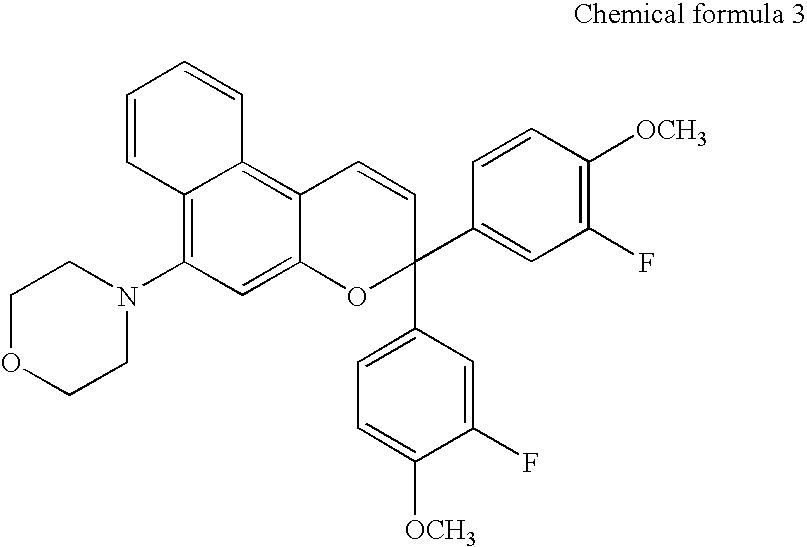Process for producing photochromic optical articles
a technology of photochromic optical articles and processing methods, applied in the direction of optical elements, synthetic resin layered products, instruments, etc., can solve the problem of insufficient effects, and achieve the effect of low solvent resistance, simple drying method, and without deterioration of coating properties
- Summary
- Abstract
- Description
- Claims
- Application Information
AI Technical Summary
Benefits of technology
Problems solved by technology
Method used
Image
Examples
example 1
(Preparation of Photochromic Coating Agent)
[0114]Firstly, 2,2-bis(4-methacryloyloxy pentaethoxyphenyl)propane, polyethyleneglycol diacrylate having an average molecular weight of 532, trimethylolpropane trimethacrylate, polyester oligomer hexacrylate (manufactured by Dicel UCB, EB-1830), and glycidyl methacrylate, which are radical polymerizing monomers, were mixed in amounts of 50 parts by mass, 15 parts by mass, 15 parts by mass, 10 parts by mass and 10 parts by mass, respectively. Subsequently, 100 parts by mass of the radical polymerizing monomer mixture was sufficiently mixed with
[0115]2.35 parts by mass of a photochromic compound (PC-1) having a structure represented by the above formula 1,
[0116]0.6 part by weight of a photochromic compound (PC-2) having a structure represented by the above formula 2, and
[0117]0.4 part by mass of a photochromic compound (PC-3) having a structure represented by the above formula 3. Thereafter, the resulting mixture was sufficiently mixed with 0...
example 2
[0140]The procedure of Example 1 was repeated except for using, as a primer, one liquid type polyurethane dispersion having a silanol group in which a dispersing medium is water, namely commercially available “Takelac WS-5000” manufactured by Mitsui Chemicals Polyurethanes, INC., and thereby a lens having a photochromic layer was prepared. The evaluation was carried in the same manner as in Example 1. The results are summarized in Table 1-1.
example 3
[0141]The procedure of Example 1 was repeated except for using, as a primer, a primer (A), which comprises an emulsion of a urethane resin having an acryloyloxy group dispersed in water, prepared by using polyether polyol as a compound having an active hydrogen group, and thereby a lens having a photochromic layer was prepared. The evaluation was carried in the same manner as in Example 1. The results are summarized in Table 1-1.
PUM
| Property | Measurement | Unit |
|---|---|---|
| Tg | aaaaa | aaaaa |
| thickness | aaaaa | aaaaa |
| thickness | aaaaa | aaaaa |
Abstract
Description
Claims
Application Information
 Login to View More
Login to View More - R&D
- Intellectual Property
- Life Sciences
- Materials
- Tech Scout
- Unparalleled Data Quality
- Higher Quality Content
- 60% Fewer Hallucinations
Browse by: Latest US Patents, China's latest patents, Technical Efficacy Thesaurus, Application Domain, Technology Topic, Popular Technical Reports.
© 2025 PatSnap. All rights reserved.Legal|Privacy policy|Modern Slavery Act Transparency Statement|Sitemap|About US| Contact US: help@patsnap.com



